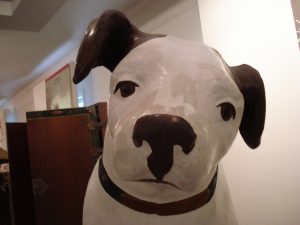Johnson Victrola Museum History

The Johnson Victrola Museum is a tribute to Delaware’s native son, Eldridge Reeves Johnson, who founded the Victor Talking Machine Company in 1901. Exhibits include phonographs, recordings, memorabilia, trademarks, objects, and paintings that highlight Mr. Johnson’s successful business enterprises and chronicle the development of the sound-recording industry.
E.R. Johnson

Born in Wilmington, Delaware, E.R. Johnson is remembered as a businessman, innovator, philanthropist, and pioneer in the recording industry.
Growing up in Dover, Delaware, Johnson graduated from the Dover Academy in 1882, but was considered not smart enough to go to college and was encouraged to learn a trade.
Johnson went on to become a machinist, working in Camden, New Jersey. There he was approached by Emile Berliner, inventor of the gramophone and disc record. He was tasked with inventing a motor that would play discs at a continuous speed, eliminating the need to constantly crank a gramophone by hand. Johnson’s spring motor invention was a success.
By 1901, Johnson had Berliner’s patents, combined them with his own, and founded the Victor Talking Machine Company. The company grew to encompass 10 city blocks in Camden, grossed millions annually, and produced some of the most famous recording artists in the world. Johnson’s international sales offices were located worldwide in countries such as Australia, Buenos Aires, Japan, and Milan.
Johnson’s innovation led to the sale of millions of Victrolas all manufactured with the public in mind. After nearly 30 years in the industry, Johnson retired in 1927. The Victor Talking Machine Company was later sold to RCA in 1929.
In 1985, Johnson received a Grammy Award presented posthumously, now proudly on display at the Johnson Victrola Museum in Dover, Delaware.
Who is Nipper?

The iconic image of a mixed fox/bull terrier, Nipper, looking into a phonograph became an international symbol of quality and excellence for The Victor Talking Machine Company.
Nipper was a real dog who lived in England and enjoyed chasing rats, “nipping at the backs of people’s ankles, and listening to music.” Reportedly, Nipper was doing just that when artist Francis Barraud thought the scene would make a great painting and created Nipper listening to “His Master’s Voice” in 1899.
The painting and copyright were purchased for use as the trademark for The Gramophone Company in London. The original painting featured Nipper listening to a cylinder phonograph but was changed to a Berliner Disc Gramophone as a condition of the purchase.
E.R. Johnson acquired the U.S. rights to the painting from Emile Berliner in 1901, leading to its use by a The Victor Talking Machine Company. Johnson, an astute businessman, launched Nipper’s image and company name to world-wide fame by branding everything from Victrolas and recordings to salt and pepper shakers. Nipper is buried in Kingston-Upon-Thames in England.


